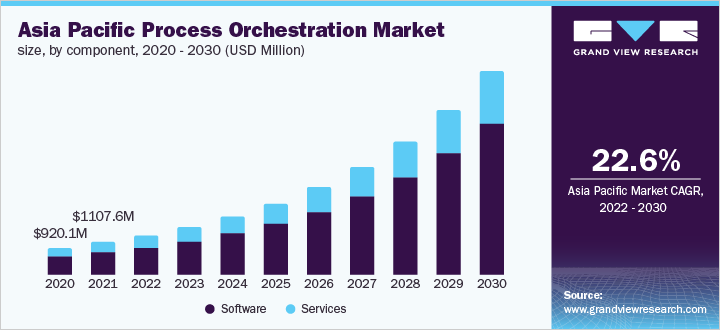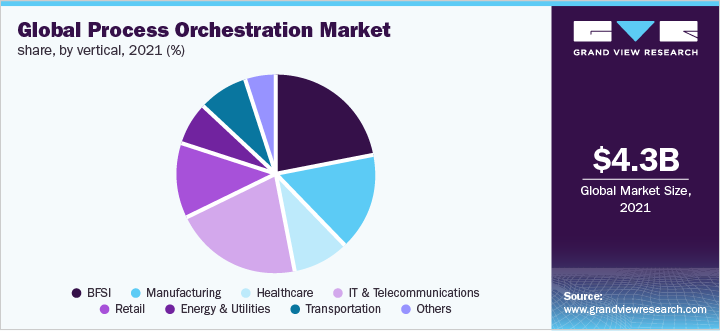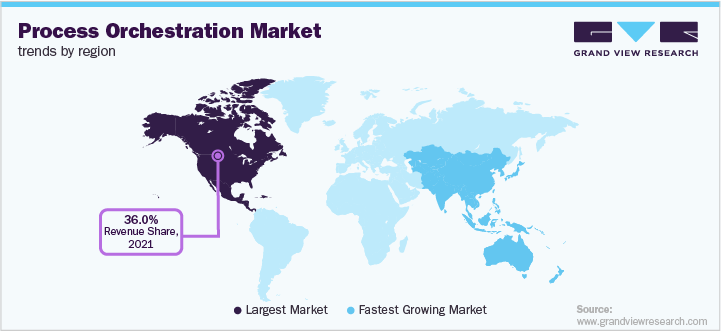- Home
- »
- Next Generation Technologies
- »
-
Process Orchestration Market Size & Share Report, 2022-2030GVR Report cover
![Process Orchestration Market Size, Share & Trends Report]()
Process Orchestration Market Size, Share & Trends Analysis Report By Component (Software, Services), By Deployment Model (Cloud, On-premise), By Enterprise Size, By Vertical, By Region, And Segment Forecasts, 2022 - 2030
- Report ID: GVR-4-68039-987-1
- Number of Report Pages: 100
- Format: PDF, Horizon Databook
- Historical Range: 2017 - 2020
- Forecast Period: 2022 - 2030
- Industry: Technology
Report Overview
The global process orchestration market size was valued at USD 4.35 billion in 2021 and is expected to expand at a compound annual growth rate (CAGR) of 20.4% from 2022 to 2030. The rising footprint of business process orchestration tools is mainly attributed to reduced cycle time, decreased cost of ownership, and enhanced compliance. Process orchestration has become highly sought-after to foster resiliency, boost mean time to resolution (MTTR), and integrate advanced tools and technologies with a single orchestrated platform. Of late, industry participants have banked on process orchestration solutions that can cash in on business process management (BPM) with analytics and automation. With machine learning and IoT gaining traction globally, orchestration could provide impetus to BPM fueling the market’s growth.

Process orchestration plays an invaluable role in executing, managing, and monitoring business processes. The platform enables users to optimize workflows involving several steps, leveraging users to emphasize high-value work. Prominently, it leverages organizations to streamline operations and complements strategic decision-making. Some upsides, such as freeing up invaluable IT resources, minimizing cost, and boosting operational efficiency, have propelled process orchestration market forecast. Furthermore, process orchestration tools have also received an uptick to minimize CAPEX ad OPEX and bolster agility.
Post COVID-19 Outlook
The onset of the COVID-19 pandemic compelled industries to seek work-from-home norms amidst health and economic crisis, prompting a major shift in working patterns. Process orchestration tools witnessed robust demand to streamline robotic tasks and orchestrate workflow across the human and digital workforce to propel brand positioning. The post-pandemic outlook indicates an increasing footfall of advanced technologies, including the cloud. Industry players anticipate process orchestration to gain further traction to automate decisions, foster data quality, and expedite the deployment and modeling of business process applications.
Component Insights
In terms of revenue, the software segment is accounted for the dominant share of 68.7% in 2021. Stakeholders expect process orchestration software to gain considerable growth during the forecast period. The trend is primarily linked to bullish demand from BFSI, IT & telecommunication, healthcare, and retail sectors, among others. Process orchestration software has received an uptick to connect previously siloed systems. Industry participants are also counting on process orchestration to streamline system integration.
Process orchestration services could witness increased traction in the wake of soaring demand for real-time monitoring. Prominently, expanding penetration of 5G, IoT, AI and natural language processing (NLP) has provided growth avenues for service providers. Leading companies have also emphasized professional services and cloud orchestration services that could drive the growth of the process orchestration market. Prominently, the use of orchestration services will be noticeable with the growing footfall of smart automation.
Deployment Model Insights
The on-premises deployment segment will contribute significantly to the global industry, accounting for over 60% of the total revenue share. The leading share can be attributed to the availability of data on demand. Industry players are also poised to seek on-premise for integrating and scheduling tasks. It will gain further traction for managing outages, migrating repositories, and deploying non-repository items. Besides, on-premise deployment will also be sought to install updates, manage releases and handle sensitive information, encouraging leading companies to inject funds into the landscape.
The cloud segment is projected to witness the highest growth rate over the forecast period, partly due to the growing prominence of cloud management solutions. Cloud process orchestration tools, including public and private clouds, will be highly sought-after across the end-use sectors. The use of cloud technologies to integrate automated tasks into a workflow and keep up with the security protocols and policies will augur well for the process orchestration industry forecast.
Leading cloud providers, such as Google, AWS, Microsoft, and IBM, are poised to expand their footfall to help businesses boost their productivity at reduced costs. For instance, in September 2021, IBM teamed up with Telefónica to help the latter modernize its 5G core network platform. The new network is reportedly built on IBM Cloud Pak forRed Hat OpenShift, Network Automation, and Juniper networking to provide streamlined end-to-end orchestration and operations.
Enterprise Size Insights
The large enterprises segment accounted for nearly 60% of the revenue share in 2021 in light of the strong demand for predictive approaches to maintain data security. The growth is also attributed to the adoption of state-of-the-art technologies and bullish investments in the IT portfolio. Organizations are likely to seek process orchestration to monitor and centralize large workflows and integrate novel technologies from one platform. Furthermore, the need to manage audit and compliance requirements from a centralized portal will propel the growth of the industry.
The small and medium enterprises segment is expected to expand with a notable CAGR during the assessment period. The growth trajectory is largely due to the need to reduce OPEX when automating and streamlining business workflows and manual tasks. SMEs are likely to exhibit an increased inclination for process orchestration to consolidate and coordinate various tools. Furthermore, the ensuing market disruptions against the backdrop of the COVID-19 pandemic prompted SMEs to reimagine their strategies to remold their businesses to improve user experience and emerge more competitive in the global market.
Vertical Insights
The BFSI segment held a leading share of over 22% in the global revenue in 2021. The BFSI sector has exhibited increased traction for process orchestration following the expanding footfall of digitization across emerging and advanced economies. With remote onboarding and automated account opening receiving impetus, banks and financial institutions will add fillip to the market growth. Banks and financial institutions are poised to bank on orchestration for regulatory alignment, transparency and business transformation.

The healthcare sector is estimated to have prominent growth during the forecast period in the wake of technological advancements across the business vertical. An uptick in automation has enabled healthcare service providers to optimize time-consuming processes and boost efficiencies with an increased focus on personalized healthcare and connected healthcare devices. Additionally, a notable shift of point-of-care from hospitals to homes has reinforced the growth of digital health, auguring well for leading companies to solidify their positions in the global industry.
Regional Insights
In terms of revenue, North America is expected to account for the leading share of 36% in 2021. North America is slated to provide promising growth opportunities with bullish digital transformation across the retail sector. Retailers across the U.S. and Canada could exhibit strong demand for process orchestration to boost operation, inventory, finance, and security.

For instance, an increased emphasis on AI has improved customer experience and retail operations. Inventory management has been streamlined using traffic, weather, and trends. Furthermore, Process orchestration could modernize stores amidst the onslaught of the COVID-19 outbreak. To illustrate, the pandemic pushed more consumers to spend online, encouraging retailers to value automated processes. The Adobe Digital Economy Index indicated that U.S. consumers spent USD 1.7 trillion online from March 2020 through February 2022. Prevailing trends indicate industry participants will expand their penetration across the U.S. and Canada to gain a competitive edge.
Stakeholders anticipate Asia Pacific process orchestration market value to be pronounced on the back of soaring digitization and adoption of AI and ML. Moreover, the expansion of the information and technology sector across China and India has fostered regional growth. The proliferation of data, along with the rising prominence of professional services, including training & education, and consulting, has provided an impetus to the APAC market. With the need for flexibility and speed gaining ground, process orchestration tools and software are likely to be sought across emerging economies and advanced economies.
Key Companies & Market Share Insights
The competitive landscape suggests forward-looking companies will emphasize boosting existing products, launching new products, and optimizing pricing structures. In addition, leading companies could seek outside opportunities, including joint ventures and mergers & acquisitions. Stakeholders could also focus on technological advancements and product differentiation. Concerted efforts on organic and inorganic growth strategies are likely to help companies expand their penetration across untapped areas.
As digitization and AI bring a paradigm shift, leaders and organizations are poised to focus on sustainable strategies and geographical expansion. For instance, in December 2021, Oracle acquired Federos to propel operational efficiency and reduce costs. The acquisition would also provide AI-driven service and network assurance, automated orchestration, and analytics. In May 2022, Wipro reportedly chose RISE with SAP to foster innovation across its business portfolio. Some prominent players in the global process orchestration market include:
-
SAP SE
-
Cisco Systems, Inc.
-
Oracle Inc
-
Wipro Ltd
-
TIBCO
-
Everteam
-
BMC
-
CA Technologies
-
Cortex
-
ServiceNow
-
Newgen Software
-
IBM Corporation
Process Orchestration Market Report Scope
Report Attribute
Details
Market size value in 2022
USD 5.15 billion
Revenue forecast in 2030
Growth rate
CAGR of 20.4% from 2022 to 2030
Base year for estimation
2021
Historical data
2017 - 2020
Forecast period
2022 - 2030
Quantitative units
Revenue in USD Million and CAGR from 2022 to 2030
Report coverage
Revenue forecast, company ranking, competitive landscape, growth factors, and trends
Segment scope
Component, deployment model, enterprise size, vertical, region
Region scope
North America; Europe; Asia Pacific; South America; Middle East & Africa
Country scope
U.S.; Canada; Mexico; Germany; U.K.; France; China; Japan; India; Brazil
Key companies profiled
SAP SE; Cisco Systems Ltd.; Oracle Inc.; Wipro Ltd; TIBCO; Everteam; BMC; CA Technologies; Cortex; ServiceNow; Newgen Software; IBM Corporation
Customization scope
Free report customization (equivalent up to 8 analysts’ working days) with purchase. Addition or alteration to country, regional & segment scope
Pricing and purchase options
Avail customized purchase options to meet your exact research needs. Explore purchase options
Global Process Orchestration Market Segmentation
This report offers revenue growth forecasts at the global, regional, and country levels and provides an analysis of the latest industry trends in each of the sub-segments from 2017 to 2030. For this study, Grand View Research has segmented the global process orchestration market report based on component, deployment model, enterprise size, vertical, and region:
-
Component Outlook (Revenue, USD Million, 2017 - 2030)
-
Software
-
Services
-
-
Deployment Outlook (Revenue, USD Million, 2017 - 2030)
-
Cloud
-
On-Premises
-
-
Enterprise Size Outlook (Revenue, USD Million, 2017 - 2030)
-
Large Enterprises
-
Small & Medium Enterprises
-
-
Vertical Outlook (Revenue, USD Million, 2017 - 2030)
-
BFSI
-
Manufacturing
-
Healthcare
-
IT & Telecommunications
-
Retail
-
Energy & Utilities
-
Transportation
-
Others
-
-
Regional Outlook (Revenue, USD Million, 2017 - 2030)
-
North America
-
U.S.
-
Canada
-
Mexico
-
-
Europe
-
U.K.
-
Germany
-
France
-
-
Asia Pacific
-
China
-
Japan
-
India
-
-
South America
-
Brazil
-
-
Middle East & Africa (MEA)
-
Frequently Asked Questions About This Report
b. The global process orchestration market size was estimated at USD 4.35 billion in 2021 and is expected to reach USD 5.15 billion in 2020.
b. The global process orchestration market is expected to grow at a compound annual growth rate of 20.4% from 2022 to 2030 to reach USD 22.79 billion by 2030.
b. North America dominated the process orchestration market with a share of 36% in 2021. This is attributable to the bullish demand to boost resiliency and integrate advanced technologies and tools with a single orchestration platform.
b. Some key players operating in the process orchestration market include IBM Corporation, SAP SE, Cisco Systems Inc., Oracle Inc., Wipro Ltd, TIBCO, Everteam, BMC, CA Technologies, Cortex, ServiceNow, and Newgen Software
b. Key factors that are driving the market growth include increasing adoption of a cloud-based solution, prominent growth of technology, and rising demand for automated systems and solutions
Share this report with your colleague or friend.
![gvr icn]()
NEED A CUSTOM REPORT?
We can customize every report - free of charge - including purchasing stand-alone sections or country-level reports, as well as offer affordable discounts for start-ups & universities. Contact us now
![Certified Icon]()
We are GDPR and CCPA compliant! Your transaction & personal information is safe and secure. For more details, please read our privacy policy.
We are committed towards customer satisfaction, and quality service.
"The quality of research they have done for us has been excellent."





